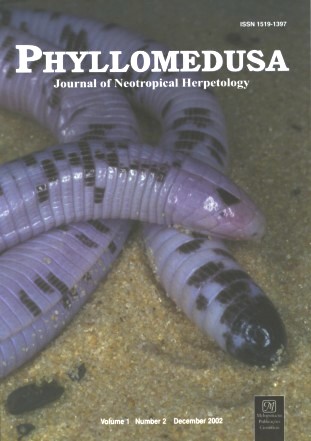Neotropical tadpoles: spatial and temporal distribution and habitat use in a seasonal lake in Veracruz, México
DOI:
https://doi.org/10.11606/issn.2316-9079.v1i2p81-91Keywords:
Smilisca baudinii, Gastrophryne usta, Rana berlandieri, tadpoles, Anura, habitat use, temporal distribution, MexicoAbstract
We studied a tadpole assemblage in a seasonal neotropical lake where 14 species of anurans reproduce. Tadpoles were collected monthly at nine sampling stations at depth intervals of 1 m from the surface to the bottom (13 m). Sufficient numbers of tadpoles of three species were collected to compare habitat use. This three species assemblage breed in the following order (first to last): Smilisca baudinii, Gastrophryne usta, and Rana berlandieri. R. berlandieri had the greatest microhabitat breadth followed by S. baudinii. S. baudinii and G. usta had high microhabitat overlap, but significant differences in microhabitat use were found. S. baudinii tended to occur near the bottom, while G. usta was near the surface. This study shows that temporal and habitat partitioning both occur and depend on the species of tadpole. Dynamic interactions occur between habitat and temporal dimensions. Phenology and habitat selection depend both on the species and on abiotic and biotic factors.Downloads
Downloads
Published
2002-12-01
Issue
Section
Articles
License
All material originally published in Phyllomedusa belongs to Escola Superior de Agricultura Luiz de Queiroz - Universidade de São Paulo. All contents are under a license of Creative Commons BY-NC-ND.How to Cite
Torres-Orozco, R. E., Jimenez-Sierra, C. L., Vogt, R. C., & Benitez, J.-L. V. (2002). Neotropical tadpoles: spatial and temporal distribution and habitat use in a seasonal lake in Veracruz, México. Phyllomedusa: Journal of Herpetology, 1(2), 81-91. https://doi.org/10.11606/issn.2316-9079.v1i2p81-91



 Impact Factor (JCR): 0.600
Impact Factor (JCR): 0.600 CiteScore: 1.0
CiteScore: 1.0